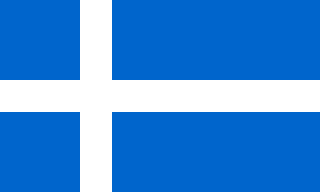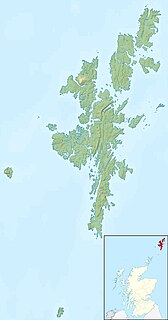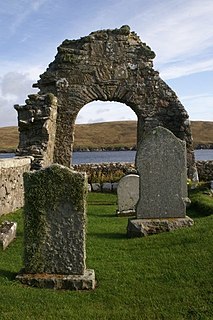Related Research Articles

The Hanseatic League was a commercial and defensive confederation of merchant guilds and market towns in Northwestern and Central Europe. Growing from a few North German towns in the late 1100s, the league came to dominate Baltic maritime trade for three centuries along the coasts of Northern Europe. Hansa territories stretched from the Baltic to the North Sea and inland during the Late Middle Ages, and diminished slowly after 1450.

The North Sea is a sea of the Atlantic Ocean located between Great Britain, Denmark, Norway, Germany, the Netherlands, Belgium and France. An epeiric sea on the European continental shelf, it connects to the ocean through the English Channel in the south and the Norwegian Sea in the north. It is more than 970 kilometres (600 mi) long and 580 kilometres (360 mi) wide, with an area of 570,000 square kilometres (220,000 sq mi).

Shetland, also called the Shetland Islands and formerly Zetland, is a subarctic archipelago in the Northern Isles of Scotland, situated in the Northern Atlantic, between Great Britain, the Faroe Islands and Norway. It is the northernmost part of Scotland and the wider United Kingdom.

Yell is one of the North Isles of Shetland, Scotland. In the 2011 census it had a usually resident population of 966. It is the second largest island in Shetland after the Mainland with an area of 82 square miles (212 km2), and is the third most populous in the archipelago, after the Mainland and Whalsay.

Fetlar is one of the North Isles of Shetland, Scotland, with a usually resident population of 61 at the time of the 2011 census. Its main settlement is Houbie on the south coast, home to the Fetlar Interpretive Centre. Fetlar is the fourth-largest island of Shetland and has an area of just over 4,000 hectares (15 sq mi).

Unst is one of the North Isles of the Shetland Islands, Scotland. It is the northernmost of the inhabited British Isles and is the third-largest island in Shetland after the Mainland and Yell. It has an area of 46 square miles (120 km2).

Bressay is a populated island in the Shetland archipelago of Scotland.

Papa Stour is one of the Shetland Islands in Scotland, with a population of under fifteen people, some of whom immigrated after an appeal for residents in the 1970s. Located to the west of mainland Shetland and with an area of 828 hectares, Papa Stour is the eighth largest island in Shetland. Erosion of the soft volcanic rocks by the sea has created an extraordinary variety of caves, stacks, arches, blowholes, and cliffs. The island and its surrounding seas harbour diverse populations of wildlife. The west side of the island is a Site of Special Scientific Interest and the seas around the island are a Special Area of Conservation.

Whalsay is the sixth largest of the Shetland Islands in the north of Scotland.

Mousa is a small island in Shetland, Scotland, uninhabited since the nineteenth century. The island is known for the Broch of Mousa, an Iron Age round tower, and is designated as a Special Protection Area for storm-petrel breeding colonies.

The Northern Isles are a pair of archipelagos off the north coast of mainland Scotland, comprising Orkney and Shetland. The climate is cool and temperate and much influenced by the surrounding seas. There are a total of 26 inhabited islands with landscapes of the fertile agricultural islands of Orkney contrasting with the more rugged Shetland islands to the north, where the economy is more dependent on fishing and the oil wealth of the surrounding seas. Both have a developing renewable energy industry. They also share a common Pictish and Norse history. Both island groups were absorbed into the Kingdom of Scotland in the 15th century and remained part of the country following the formation of the Kingdom of Great Britain in 1707, and later the United Kingdom after 1801. The islands played a significant naval role during the world wars of the 20th century.

Balta is an uninhabited island in Shetland, Scotland.

Vaila is an island in Shetland, Scotland, lying south of the Westland peninsula of the Shetland Mainland. It has an area of 327 hectares (1.26 sq mi), and is 95 metres (312 ft) at its highest point.
The Skåne Market or Scania market was a major fish market for herring which took place annually in Scania during the Middle Ages. From around 1200, it became one of the most important events for trade around the Baltic Sea and made Scania into a major distribution center for West-European goods bound for eastern Scandinavia. The Scania Market continued to be an important trade center for 250 years and was a cornerstone of the Hanseatic League's wealth.

Scalloway is the largest settlement on the North Atlantic coast of Mainland, the largest island of the Shetland Islands, Scotland. The village had a population of roughly 900, at the 2011 census. Until 1708 it was the capital of the Shetland Islands.

Northmavine or Northmaven is a peninsula on the northernmost part of the Shetland mainland in Scotland. The peninsula has historically formed the civil parish Northmavine. The modern Northmavine community council area has the same extent. The area of the parish is given as 204.1 km².

Symbister is the largest village and port on Whalsay, an island in the Shetland archipelago of Scotland. The population in 1991 was 797. The focus of the village is the harbour, which is home to small fishing boats as well as large deep sea trawlers. The village is overlooked by the granite mansion Symbister House, built by the Sixth Robert Bruce of Symbister in 1823. The harbour is also known by the names Bay Of Symbister, Symbister Harbour and Symbister Old Harbour.

The Böd of Gremista, situated at the north end of Lerwick, Shetland, Scotland, is a typical 18th century Shetland fishing booth. It is protected as a category B listed building.

Sandsting is a parish in the West Mainland of Shetland, Scotland, forming a southern arm of the Walls Peninsula. After the parish of Aithsting was annexed into Sandsting in the sixteenth century, it became known as Sandsting and Aithsting parish.
The History of Shetland concerns the subarctic archipelago of Shetland in Scotland. The early history of the islands is dominated by the influence of the Vikings. From the 14th century it was incorporated into the Kingdom of Scotland, and later into the United Kingdom.
References
- 1 2 3 Julian Holland (1 January 2009). Exploring the Islands of Scotland: The Ultimate Practical Guide. frances lincoln ltd. pp. 49–. ISBN 978-0-7112-2758-3 . Retrieved 3 January 2013.
- ↑ Smith, Roger; Woolnough, Kristina (1992). Highlands and islands. W & R Chambers. p. 55. ISBN 978-0-550-22100-1 . Retrieved 5 February 2013.
- ↑ Owen, Olwyn; Lowe, Christopher (1999). Kebister: The Four-thousand-year-old Story of One Shetland Township. Society Antiquaries Scotland. p. 300. ISBN 978-0-903903-14-1 . Retrieved 5 February 2013.
Coordinates: 60°20′31″N1°01′30″W / 60.34206°N 1.02508°W
| | This article about a Shetland building or structure is a stub. You can help Wikipedia by expanding it. |